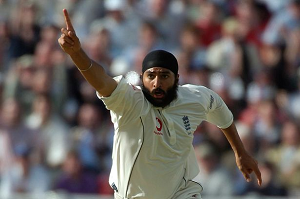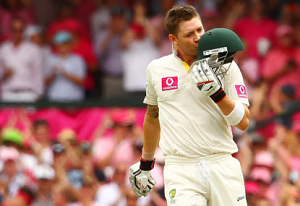Western Suburbs District Cricket Club - Pratten Park has been the home for 33 Test Cricketers
Western Suburbs District Cricket Club Sydney | May 05, 2023

Western Suburbs can lay claim to 33 Test Internationals passing through the gates of Pratten Park and playing for the Magpies…
20 of these International Players represented Australia while active as a Western Suburbs Player and, remarkably, two Angus Fraser and Monty Panesar were selected for England while in the Wests ranks.


Mitchell STARC, who debuted in Wests First Grade in 2007, continues to spearhead the Australian attack.
However, it all started in March of 1877, in the First Test match in Melbourne, when Tom GARRETT debuted at age 18 years and 232 days…which still makes him the youngest representative to play for Australia against England. Tom was educated at Newington College while the School was still at ‘Newington House’, in the Sydney suburb of Silverwater.

A tall all-rounder, Tom GARRETT played for NSW, batting and bowling right handed. Bowling was his strength. He played 19 Tests, scoring 339 runs at 12.55 and taking 36 wickets at 26.94, with best figures of 6/78.
Tom is the great grandfather of Midnight Oil lead singer, Peter Garrett.

Roland POPE, born in Ashfield, played one Test in 1885, also in Melbourne. ‘Rowley’s’ opportunity came due to the fact that several senior Australian Players refused to play in protest at the “payment arrangements” for the first Two Tests against England. While studying Medicine in the UK, Pope represented the Marylebone Cricket Club from 1889 – 1891.

John James FERRIS played 9 Tests, commencing during England’s Tour here in 1886-87. ‘J.J’ had taken 7 wickets for NSW against the Tourists, propelling him into the First Test in Sydney. England recorded their lowest ever score of 45…but they managed to scramble through with a 13 run win.
In 1889, Ferris was named as one of the first Wisden Cricketers of the Year. In 9 Tests he had taken 61 wickets at the lowly average of 12.70. John Ferris stayed in England after the 1890 Tour and ultimately played one test for his adopted country, in 1891 -92, against South Africa.

Gervys Rignold HAZLITT, called ‘Gerry’, also played 9 Tests. He was born in Enfield…and was buried in St. Thomas’ church, Enfield in 1915.
A right arm medium pace and off spin bowler and useful lower order batsman, Hazlitt toured England with the 1912 Australian Team. In his last Test, at the Oval, he took 7/25 in the second innings. In his first Test, versus England at Sydney in 1907-08, he made 34 not out and put on 56, in 39 minutes, for the 9th. wicket, with Tibby Cotter, to give Australia victory by 2 wickets. Gerry HAZLITT died of a heart attack, only 27 years old.

Harry DONNAN, a right hand bat and medium pace bowler, was born at Liverpool in 1864 and played five Test Matches for Australia. Unfortunately, success eluded Harry at Test level, producing a batting average of only 8.33 and no wickets. He fared better in first class cricket, taking 29 wickets in his 94 games and achieving a batting average of 29.19. Donnan scored 6 centuries and 22 ‘fifties’.

John Denis Alphonsus O’CONNOR [call him ‘Jack’], came to Western Suburbs from Boorowa in NSW…and died at Lewisham aged 65. O’CONNOR played 4 Tests, taking 5 wickets on debut in the second innings against England in the Adelaide Test of 1908.

Warren ‘Curly’ BARDSLEY, an opening batsman, played 41 Tests between 1909 and 1926 and over 200 first–class games for NSW. He was Wisden’s Cricketer of the Year in 1910. On his first tour of England in 1909, Bardsley struggled in his first 4 Tests [120 runs at 15], however, in the Fifth Test at the Oval, he became the first cricketer to score a century in each innings of a Test match.
Warren BARDSLEY made his last tour of England in 1926, inheriting the captaincy on the trip, thus becoming the oldest Australian debutant captain at 43 years and 216 days. He played all 5 Tests on Tour, his undefeated innings of 193 at Lord’s would be his highest Test score and it made him the oldest Player to score a Test century for Australia.

Arthur CHIPPERFIELD was born in Ashfield, but played his early cricket at The Entrance. He joined Western Suburbs in 1927, debuting for Australia on the 1934 Tour of England, following only 3 first-class matches. Arthur made 99 on debut at Trent Bridge, the first person to do so. Chipperfield played 14 Tests, scoring 552 runs at 32.47.

Another Wests International with a Central Coast connection, is Alan DAVIDSON AM MBE, from Lisarow near Gosford. One of Australia’s greatest all-rounders, ‘Davo’ stood 6’ tall, was a hard hitting left hand batsman, outstanding pace bowler, with late swing…and had the ability to take improbable catches, which earned him the nickname of ‘The Claw’. A mainstay of the successful Benaud captaincy era from 1957-63, Alan Davidson played 44 Tests, scoring 1,328 runs at 24.59, with a top score of 80. He took 186 wickets at the remarkable average of 20.53.
In the first Tied Test, against the West Indies in Brisbane in 1960, Alan became the first Player to score 100 runs and take 10 wickets [11, in fact] in a Test match. In all first-class games, Davo took 672 wickets at 20.90. Alan Davidson complimented his playing career with a stellar administrative career, 5 years as a national Selector…and president of NSW Cricket from 1970 to 2003.

Another contributor to Benaud’s golden era was opening batsman Bob SIMPSON AO. Bobby was born in Marrickville and became a NSW Player just 11 days short of his 17th. birthday. In a very long career, ‘Simmo’ had two stints playing with NSW, and also playing with Western Australia 1956-61. He captained Australia and Coached Australia.
Simpson succeeded Richie Benaud during 1963-64, until 1968…then was recalled to lead Australia in the World Series era, at the age of 41, 1977-78.
In 62 Test Matches, Bobby scored almost five thousand runs at 46.81 and took 71 wickets. A renowned ‘slipper’, Simpson took 110 Test catches.
In his long career with Wests, ‘Simmo’ scored 31 centuries.

Bob Simpson was captain of the 1964 Ashes Tour, for which pace bowler Grahame Corling was selected from Waratah-Mayfield in Newcastle. He then joined Wests on his return. In a rain affected series, Corling’s 12 wickets at 37.25 were an invaluable support to opening bowlers Graham McKenzie and Neil Hawke. Corling took 4/60 in the Second Test. Australia won the series 1-0, with 4 drawn.

Another Novacastrian, Gary ‘Gus’ Gilmour often earned comparisons to Alan Davidson due to his “talented hitting”, “penetrative” left arm swing bowling and strong slip catching. Gilmour scored a century on debut for NSW. ‘Gus’ forced his way into a very strong Australian Team in the mid 1970’s, playing 15 Tests, scoring 483 runs at 23.00, with a top score of 101; and taking 54 wickets at 26.03. He took 12 catches.

Wicket keeper Steve Rixon first came to public attention when the touring English ‘keeper Alan Knott applauded the 16 year-old’s efforts when he represented Southern NSW against MCC in 1970-71. Steve played 13 Tests, taking 42 catches and effecting 5 stumpings. Rixon posted a top Test score of 54.

Peter Toohey was one of the cricketers who came to the fore when the bulk of Australia’s Players defected to Kerry packer’s World Series Cricket. During Peter’s prime playing years in the Australian side, media commentators often referred to him as “Australia’s master batsman”, such was his pivotal role in the team. Toohey played 15 tests, scoring 893 runs [one century and 7 ‘fifties’] at 31.89, with a top score of 122.

Dirk Wellham, born in Summer Hill, was the first Player to captain three states [NSW, Tasmania and Queensland]. As NSW captain, he won the Sheffield Shield in consecutive seasons: 1984-85 and 85-86. Dirk toured with the 1981 Ashes side and scored a century on debut in the 6th. Test at The Oval. At first-class level, Wellham scored 8662 runs at 42.25, including 16 centuries, in a long career that concluded in 1993.

Greg Matthews was a genuine all-rounder: an off-spin bowler and left hand batsmen. When Australian cricket was in the doldrums in the mid 1980’s, his dashing batting and growing ability as a spin bowler elevated ‘Mo’ to a position of ‘national hero’. In 33 Test Matches, Matthews scored 1,849 runs at 41.08, including a top score of 130. He took 61 wickets at 48.22. Greg took 10 wickets in the famous Tied Test at Chennai in September, 1986, including the last “to make history”. ‘Mo’ also contributed 44 and 27 not out, with the bat in that match.

A recent Chairman of Western Suburbs, fast bowler David Gilbert was 12th. Man in that Tied Test. Dave played 9 Tests and 14 One day Internationals for his country, touring England, New Zealand and India, where he scored a first-class century. Overall, in first-class, Dave took 354 wickets at 32.39. Gilbert’s administrative career includes CEO of Surrey and Sussex County Clubs and 11 years as CEO of Cricket NSW. He is currently a Cricket Australia match referee.

Like Dirk Wellham, wicketkeeper Greg Dyer came through the Western Suburbs junior system, winning the Green Shield in successive seasons. Dyer played in 6 Tests between 1986 and ’88 [with 22 catches and 2 stumpings]. His Test batting average is 21.83. Greg toured India in ’86 and was in the victorious 1987 World Cup Final. Greg Dyer is currently President of the Australian Cricketers Association.

Michael Clarke also came through the Wests ranks, from age 13. He led Australia to a World Cup victory [our 5th.] at the MCG in 2015. ‘Pup’ played 115 Test Matches, 47 as captain. A very useful left arm orthodox spinner [when his back allowed him to bowl], taking 31 Test wickets at 38.19, including two ‘five fas’. A right hand bat, Clarke scored 8643 Test runs at 49.10, including 28 centuries and 27 fifties, with a highest score of 329 not out at Sydney, versus India, on January 5th., 2012.

Left handed opening bat, Phillip Hughes, joined Wests as a teenager from Macksville, NSW and attended Homebush High. While he later played for South Australia and Worcestershire, Phillip played two seasons for NSW, where he debuted for Australia in 2009, aged 20. He scored his first Test century (115) in the first innings of his second Test, at Durban, the youngest Aussie Test centurian since Doug Walters in 1965. Hughes scored 160 in the second innings of that match, becoming the youngest cricketer in history to score centuries in both innings of a Test. In 2013, Phillip became the first Aussie bat in the history of ODI cricket to score a century on debut [versus Sri Lanka in Melbourne]. Phillip Hughes played 26 Tests, scoring 1,535 runs at 32.66.

Mitchell Starc, at 196 cms [6’5”] is a genuinely fast left-arm fast-bowler, who was brought up in Lidcombe. He is currently Australia’s established opening bowler, recently silencing the critics by taking ten wickets [at just ten each] in his 51st. Test.
Also a hard-hitting batsman, ‘Starcy’ has a highest Test score of 99. In the 2016 Boxing Day Test, he broke Andrew Symond’s record of most sixes in an innings, hitting seven.
At the time of publishing Mitchell Starc has played 77 Test and taken 306 Test wickets at an average of 27.52.…with more to come!
There have been three Western Suburbs Grade Players to Captain Australia:
- Warren Bardsley
- Bob Simpson
- Michael Clarke








